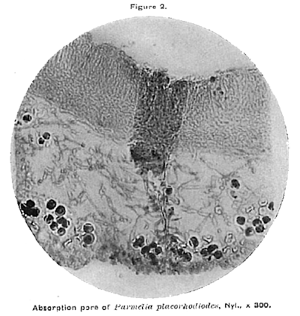Case Studies
John Shirley's thesis
In 1912 Shirley was awarded the degree of Doctor of Science by the University of Sydney. As part of the work leading to the degree Shirley wrote a thesis entitled The Thallus of the genus Parmelia and his thesis work was published as a paper in the Papers and Proceedings of the Royal Society of Tasmania for 1918, published in 1919. Shirley's paper occupied pages 53 to 68 and (at the end of that volume) plates II-VII. At the beginning of his paper Shirley made it clear that his study differed from the general publications about lichens in which...
...the main object of the author is to give such a description of a species as will enable a student to determine the plant by himself, by examination of the thallus with a pocket lens, and of apothecia and spores by the aid of a microscope
Shirley did not discuss such aspects but dealt with the micro-anatomy of the thalli of several lichen species. More precisely...
In preparing the material for this paper, serial sections of the following lichens were cut, stained, and mounted for examination: Parmelia tiliacea, Ach;, P. tinctorum, Despr., P. perlata, L., P. limbata, Laur., P. laxa, M.A., P. perforata, Ach., P. latissima, Fee, P. placorhodioides, Nyl., P. mundata, Nyl., P. olivacea, L., P. cetratra v. sorediifera, Wain., and P. saxatilis v. signifera, M.A.
...
Of the material examined, the whole of the specimens are Australian with the exception of P. cetrata v. sorediata, Wain., which was chosen for special study of the development of the soredia, and also for comparison with Australian species.
He supplemented the text with twelve micro-photographs that appeared on the six plates accompanying the paper.
 Here is a link to the text pages: LINK TO SHIRLEY TEXT Here is a link to the text pages: LINK TO SHIRLEY TEXT
Here is a link to the plates: LINK TO SHIRLEY PLATES
In an obituary notice in the Proceedings of the Linnean Society of New South Wales for 1923, the society's president G.A. Waterson wrote:
Dr. Shirley's achievement in obtaining the degree of Doctor of Science at the age of 63 must be unique. Few men would face the ordeal of the examination for which it was necessary to sit, in addition to the preparation of a thesis, at such an advanced age.
|
![An Australian Government Initiative [logo]](/images/austgovt_brown_90px.gif)


 Here is a link to the text pages:
Here is a link to the text pages: